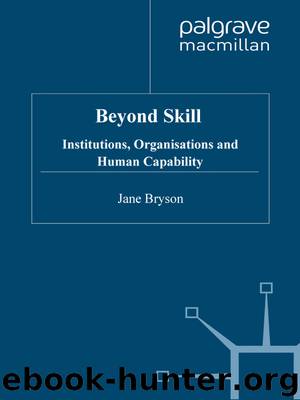Beyond Skill by Jane Bryson

Author:Jane Bryson
Language: eng
Format: epub
Publisher: Palgrave Macmillan
Published: 2009-12-31T16:00:00+00:00
7
High-Performance Work Systems
and Employee Well-being in New
Zealand
Peter Boxall and Keith Macky
There is a long tradition of interest in how to enhance worker motivation and raise organisational productivity through improving the design of work. The human relations movement, and such concepts as socio-technical work systems, industrial democracy, and job enrichment, have all had their day in the sun. The notion of ‘high-performance work systems’ (HPWSs) is the most recent manifestation of this concern. The term largely originated in the USA, where it arose in the policy and academic debate over the decline of US manufacturing competitiveness in the face of challenges from other advanced manufacturing societies, most notably Japan, and more recently, from a variety of low-cost developing countries. A landmark report in 1990, America’s Choice: High Skills or Low Wages!, issued by the Commission on the Skills of the American Workforce, expressed strong criticism of the Fordist/Taylorist models of work design prevalent in US mass-production industries, where core production jobs were often low in responsibility, discretion and skill (Cordery and Parker, 2007). It argued for substantial investment in ‘high-performance work organisation’ and in greater workforce skills (Cappelli and Neumark, 2001). This message was reinforced by Appelbaum and Batt (1994) in The New American Workplace and by Appelbaum et al (2000) in Manufacturing Advantage. These were both influential books which argued that new technology alone could not save domestic American manufacturing: reforms to work systems, which achieved higher performance through increased employee involvement, higher skills and better performance incentives, would also be needed.
High-performance work systems are thus closely connected to issues of human capability in the workplace. Advocates of HPWSs argue that they unlock and expand human capabilities and make work more satisfying (see Chapter 2). They depend for their effectiveness, in fact, on the responses of workers. In this chapter, we critically examine the notion of HPWSs and describe the results of a study of worker responses to HPWSs in New Zealand workplaces. Over the last few years, our research interest has focused on what workers experience in the workplace, including their responses to management practices and to trade unions, and how this connects to their well-being. Well-being in the workplace is a broad concept, including a range of variables such as job satisfaction, stress, fatigue, and work-life balance.
We believe that the most useful definition of HPWSs is one which is based around high-involvement work processes. We begin by unpacking the elements of HPWSs and flesh out the high-involvement model, setting up our preferred conceptual framework and reviewing research on the outcomes, both positive and negative, for workers and firms. This leads into a summary of the findings of our recent study in New Zealand of worker responses to HPWSs, drawing on two major empirical papers (Macky and Boxall, 2008a, b). We conclude with some wider observations on the potential for HPWSs in the New Zealand workplace. While our research suggests that a supervisory style which fosters empowerment is widespread in New Zealand, and that this suits both parties, more
Download
This site does not store any files on its server. We only index and link to content provided by other sites. Please contact the content providers to delete copyright contents if any and email us, we'll remove relevant links or contents immediately.
The Brazilian Economy since the Great Financial Crisis of 20072008 by Philip Arestis Carolina Troncoso Baltar & Daniela Magalhães Prates(106305)
International Integration of the Brazilian Economy by Elias C. Grivoyannis(76004)
The Art of Coaching by Elena Aguilar(52218)
Flexible Working by Dale Gemma;(23213)
How to Stop Living Paycheck to Paycheck by Avery Breyer(19573)
The Acquirer's Multiple: How the Billionaire Contrarians of Deep Value Beat the Market by Tobias Carlisle(12118)
Thinking, Fast and Slow by Kahneman Daniel(11816)
The Radium Girls by Kate Moore(11642)
The Art of Thinking Clearly by Rolf Dobelli(9941)
Hit Refresh by Satya Nadella(8871)
The Compound Effect by Darren Hardy(8531)
Atomic Habits: Tiny Changes, Remarkable Results by James Clear(8057)
Tools of Titans by Timothy Ferriss(7833)
Turbulence by E. J. Noyes(7720)
Change Your Questions, Change Your Life by Marilee Adams(7393)
A Court of Wings and Ruin by Sarah J. Maas(7290)
Nudge - Improving Decisions about Health, Wealth, and Happiness by Thaler Sunstein(7264)
How to Be a Bawse: A Guide to Conquering Life by Lilly Singh(7167)
Win Bigly by Scott Adams(6839)
